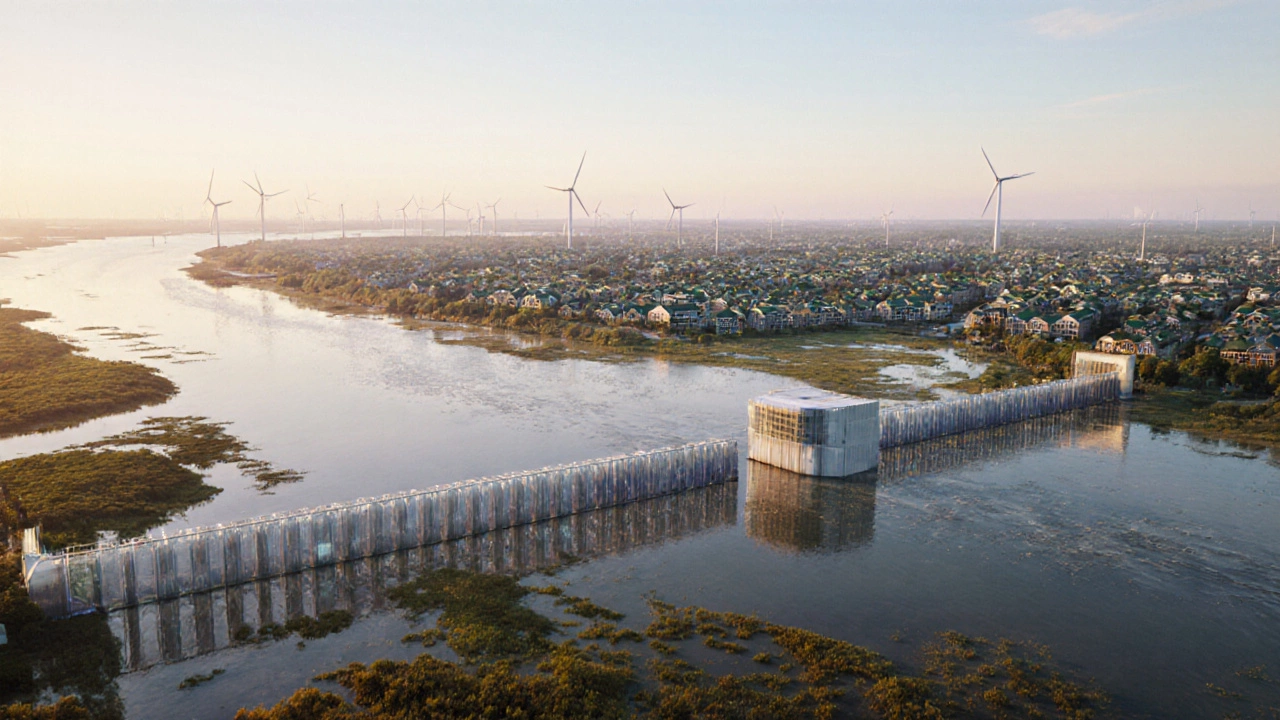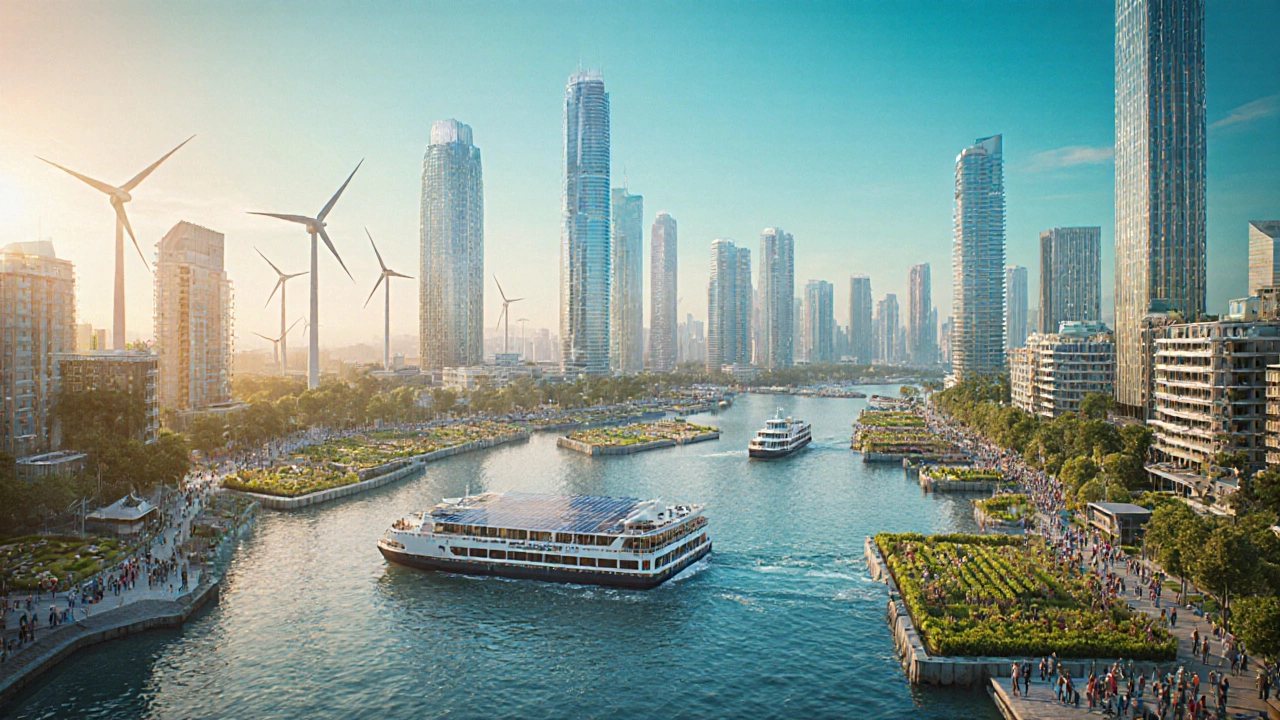World in 2100: Climate Change Impacts & Future Outlook
 Oct, 16 2025
Oct, 16 2025
Sea Level Rise Impact Calculator
Enter your location's current elevation and select a climate scenario to see potential sea level rise impacts.
Imagine standing on a Liverpool waterfront in 2100. The skyline looks familiar, yet the air feels different, the horizon stretches farther inland, and the rhythm of daily life has shifted around new climate realities. This picture isn’t science‑fiction; it’s the result of decades of data, models, and policy decisions that shape the 2100 climate future. Below we walk through the most credible projections, what they mean for societies, and which choices could tilt the balance toward a livable world.
How scientists forecast the year 2100
When you hear a forecast for 2100, the first name that should come to mind is the IPCC, the Intergovernmental Panel on Climate Change, which synthesizes thousands of peer‑reviewed studies into comprehensive assessment reports. The latest Sixth Assessment Report (AR6) uses a set of Shared Socioeconomic Pathways (SSPs) to illustrate how different emissions trajectories translate into temperature and impact outcomes.
Three scenarios dominate public conversation:
- SSP1‑2.6: a sustainability‑focused path that limits warming to about 1.5°C above pre‑industrial levels.
- SSP2‑4.5: a middle‑of‑the‑road trajectory with roughly 2.5°C warming.
- SSP5‑8.5: a high‑emissions “business‑as‑usual” route leading to about 4°C of warming.
These pathways integrate assumptions about population growth, economic development, energy use, and land‑use changes, allowing researchers to estimate impacts on everything from sea level to food security.
Projected temperature rise and its knock‑on effects
Global average temperature is the headline metric because it drives the cascade of secondary impacts. Under SSP5‑8.5, the world could warm by 4°C by the end of the century. That’s not just a hotter summer; it reshapes ecosystems, alters disease vectors, and strains infrastructure.
Key temperature‑related changes include:
- Heat‑related mortality spikes, especially for the elderly and outdoor workers.
- Expansion of the tropical disease belt, bringing malaria and dengue to previously temperate zones.
- Accelerated melting of Arctic permafrost, releasing methane-a potent greenhouse gas.
Even the lower‑emissions SSP1‑2.6 still projects a 1.5°C rise, which already triggers measurable stress on coral reefs and alpine snowpacks.
Sea level rise: reshaping coastlines
Thermal expansion of seawater and the melt of Greenland and Antarctic ice sheets drive sea level rise. The sea level rise, the gradual increase in global ocean height caused by warming temperatures could add between 0.5m and 2m by 2100, depending on emissions.
Coastal megacities-New York, Mumbai, Shanghai-face chronic flooding, loss of habitable land, and massive displacement. In the UK, low‑lying areas of East Anglia could see regular tidal inundation, demanding costly flood defenses or managed retreat.
Insurance premiums are already climbing in flood‑prone zones, and many municipalities are revisiting zoning laws to reflect the new shoreline reality.
Extreme weather becomes the new normal
Heatwaves, storms, and droughts intensify. The IPCC notes that the frequency of extreme weather, weather events that are unusually severe compared to historical norms events will double or triple under high‑emissions scenarios.
Implications include:
- Longer, more destructive wildfire seasons in the western United States and Mediterranean Europe.
- More powerful tropical cyclones in the Atlantic and Pacific, with higher storm surges.
- Prolonged droughts in Sub‑Saharan Africa, reducing crop yields and water availability.
These extremes strain emergency services, depress economic growth, and exacerbate mental‑health challenges.

Food and water security under pressure
Climate change threatens the two pillars of human survival: nutritious food and clean water. Rising temperatures reduce the yield of staple crops such as wheat, rice, and maize. Studies from the International Food Policy Research Institute (IFPRI) estimate a 10‑15% drop in global cereal yields under SSP5‑8.5.
Reduced snowpack and altered precipitation patterns shrink freshwater supplies. The World Bank projects that up to 5billion people could face water scarcity for at least one month per year by 2100.
Adaptation measures-drought‑tolerant crop varieties, efficient irrigation, and water recycling-will be essential, but they require investment and political will.
Migration, conflict, and geopolitical shifts
When livelihoods become untenable, people move. Climate‑induced migration is already evident in the Sahel, the Pacific islands, and parts of Central America.
By 2100, the migration patterns, large‑scale human movements driven by environmental stressors could involve tens of millions, reshaping labor markets and potentially sparking resource‑based conflicts.
Countries that invest in resilient infrastructure and social safety nets may attract migrants, while those that ignore climate risks could face instability.
Pathways to a livable 2100
Hope isn’t lost. The IPCC outlines a suite of mitigation and adaptation strategies that could keep warming below the most catastrophic thresholds.
| Scenario | Projected Global Mean Temp ↑ (°C) | Sea Level Rise (m) | Likelihood of >2°C Warming |
|---|---|---|---|
| SSP1‑2.6 | 1.5 | 0.5‑0.8 | Low |
| SSP2‑4.5 | 2.5 | 0.8‑1.2 | Medium |
| SSP5‑8.5 | 4.0 | 1.2‑2.0 | High |
Three overarching tracks can steer us toward a safer 2100:
- Decarbonise the energy system: Scale up wind, solar, and emerging green‑hydrogen technologies. Electrify transport and phase out coal.
- Preserve and restore natural carbon sinks: Protect existing forests, expand afforestation, and adopt regenerative agriculture.
- Strengthen adaptation capacity: Invest in flood‑resilient infrastructure, early‑warning systems, and climate‑smart health services.
Policy frameworks such as the Paris Agreement, the 2015 global pact to limit warming to well below 2°C provide a diplomatic backbone, but national commitments (NDCs) must become more ambitious.

Quick checklist: what to watch in the next decade
- Nationally Determined Contributions (NDCs) updates: are countries on track for net‑zero?
- Technology rollout: cost trends for utility‑scale storage and green hydrogen.
- Climate‑related finance: growth of green bonds and adaptation funding.
- Public health data: spikes in heat‑related illnesses and vector‑borne diseases.
- Urban planning: implementation of climate‑resilient zoning in flood‑prone cities.
What does a hopeful 2100 look like?
If the world pivots early, 2100 could still be a planet where coastal cities thrive on reclaimed land, agriculture relies on climate‑smart practices, and renewable energy powers the majority of industry. The key is coordinated action across governments, businesses, and citizens.
Frequently Asked Questions
How accurate are the 2100 climate projections?
Projections are based on sophisticated climate models that have successfully reproduced past temperature trends. Uncertainty grows with time, especially regarding socioeconomic pathways, but the range of scenarios (SSP1‑2.6 to SSP5‑8.5) reliably brackets likely outcomes.
What can individuals do to influence the 2100 outcome?
Personal choices matter when they aggregate: reducing energy consumption, supporting renewable energy providers, voting for climate‑focused policies, and advocating for sustainable infrastructure in your community.
Will sea level rise affect the UK?
Yes. Low‑lying regions such as the Thames estuary and parts of East Anglia face higher flood risk. The UK government is already investing in the Thames Estuary 2100 plan, which combines tidal barriers, wetlands restoration, and strategic retreat.
How soon will extreme weather become the norm?
Many regions are already experiencing increased frequency of heatwaves and heavy precipitation. By 2030, most climate‑sensitive sectors will notice a clear shift, with the trend accelerating through 2050 and beyond.
What role does technology play in mitigation?
Technology is a cornerstone: renewable electricity, carbon capture, low‑carbon cement, and climate‑smart agriculture can collectively cut emissions dramatically. However, technology must be paired with policy incentives and societal adoption.
Is there a chance we could reverse warming after 2100?
Reversing warming is extremely challenging because the climate system has inertia. Even with aggressive mitigation, temperatures will linger for centuries. The focus, therefore, is on limiting peak warming and enhancing resilience.